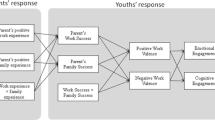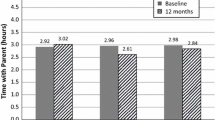Abstract
A number of respected social critics, including the President's Science Advisory Committee (PSAC), have recommended the earlier integration of adolescents into the workplace. The PSAC Panel on Youth (1973) claims that work settings provide opportunities for developing and exercising personal responsibility, taking responsibility for the welfare of others, and establishing more extensive instrumental and social relations with nonfamilial adults. This study of “naturally occurring” employment among high school students examines these claims about the nature of the workplace. Drawing on interview, questionnaire, and observational data, we argue that the PSAC's expectations are somewhat optimistic. With respect to personal responsibility taking, although many adolescent workers have opportunities for self-management and report performing assigned tasks dependably, very few report going “beyond the call of duty.” With respect to social responsibility, workers experience only modest levels of task interdependence and centrality to a team effort; yet substantial numbers of adolescent workers feel that their work serves a socially useful purpose. Finally, with respect to intergenerational contact, the workplace fails to induce meaningful interaction with adults. Taken together, the results of this study suggest that if the workplace is to become a truly vital context for adolescent socialization, it needs to be designed more deliberately with such aims in mind.
Similar content being viewed by others
References
Barry, H., Bacon, M. K., and Child, I. G. (1967). Definitions, ratings, and bibliographic sources for child training practices of 110 cultures. In Ford, C. S. (ed.),Cross-Cultural Approaches, Hraff Press, New Haven, Conn.
Coleman, J. C. (1961).The Adolescent Society, Free Press, New York.
Employment and Earnings, February 1978. (1978). U.S. Department of Labor and Bureau of Statistics. U.S. Government Printing Office, Washington, D.C.
Fortes, M. (1970). Social and psychological aspects of education in Taleland. In Middleton, J. (ed.),From Child to Adult, University of Texas Press, Austin.
Greenberger, E., and Sørensen, Aa. B. (1973). Toward a concept of psychosocial maturity.J. Youth Adoles. 3: 329–358.
Greenberger, E., and Steinberg, L. D. (1980). Part-time employment of in-school youth: A preliminary assessment of costs and benefits. InA Review of Youth Employment Problems, Programs, and Policies, Vol. 1:The youth employment problem: Causes and dimensions, Chap. 13. Vice President's Task Force on Youth Employment, U.S. Department of Labor, Washington, D.C.
Greenberger, E., Steinberg, L. D., and Ruggiero, M. (in press). A job is a job is a job ... or is it? Behavioral observations in the adolescent workplace.Sociology of work and occupation.
Greenberger, E., Steinberg, L. D., Vaux, A., and McAuliffe, S. (1980). Adolescents who work: Effects of part-time employment on family and peer relations.J. Youth Adoles. 9: 189–202.
Illich, I. (1971). The alternative to schooling.Saturday Rev. June 19, p. 44 and ff.
Interagency Panel for Research and Development in Adolescence. (1973).Work Experience as Preparation for Adulthood, Social Research Group and the George Washington University, Washington, D.C.
National Panel on High Schools and Adolescent Education. (1976).The Education of Adolescents U.S. Government Printing Office, Washington, D.C.
President's Science Advisory Committee, Panel on Youth. (1973).Youth: Transition to Adulthood, University of Chicago Press, Chicago.
Ruggiero, M., and Steinberg, L. D. (in press). The empirical study of the workplace: A behavioral code for the assessment of Adolescent job environment.J. Vocat. Behav.
Steinberg, L. D. (1982). Whither the workplace? The promise and problems of work experience for adolescence. In Simon, J., and Stipek, D. (eds.),Exit Age: Reconsidering Compulsory Education for Adolescents: Studies in Social Science, Education and Law, Academic Press, New York.
Steinberg, L. D., and Greenberger, E. (1980). The part-time employment of high school students: A research agenda.Children Youth Serv. Rev. 2: 161–185.
Stern, D., Smith, S., and Doolittle, F. (1975). How children used to work.Law Contempor. Probl. 39: 93–117.
Whiting, B. B., and Whiting, J. W. M. (1975).Children of Six Cultures. Harvard University Press, Cambridge, Mass.
Author information
Authors and Affiliations
Additional information
This study is part of a large-scale investigation of the cost and benefits of working to adolescent development. The research program is supported by the National Institute of Education and the Spencer Foundation; dissemination of policy-oriented papers is supported by the Ford Foundation. The authors, who are Co-Principal Investigators of the research program, share equal responsibility for this report.
Received Ph.D. in clinical psychology from Harvard University. Main research interests are adolescence and social institutions, life-span development, and social policy.
Received Ph.D. in human development and family studies from Cornell University. Main research interests are adolescent development, life-span development, and social policy.
Rights and permissions
About this article
Cite this article
Greenberger, E., Steinberg, L.D. The workplace as a context for the socialization of youth. J Youth Adolescence 10, 185–210 (1981). https://doi.org/10.1007/BF02088970
Issue Date:
DOI: https://doi.org/10.1007/BF02088970




